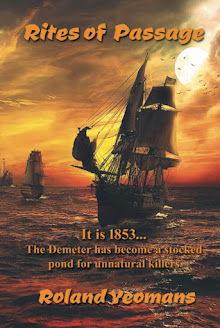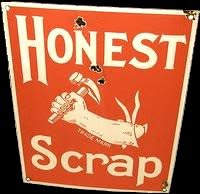
Fiction is not reality. It is something slightly different, yet the same.
Like Mark Twain said, "Fiction has to make sense."
I.) Fiction reflects reality through a mirror darkly ...
A.) That mirror reflects society's face with all its ...
1.) Blemishes
2.) Scars
3.) Hopes
4.) Its dreams and the smiles despite the inner pain of most of the people you walk past on the streets.
II.) Fiction distills reality, revealing more truth than reality does in a shorter span of time.
A.) Fiction prunes out anything that doesn't propel the story and themes forward.
B.) Fiction is more intense and dense page by page than our lives are day by day.
III.) Fiction is a crucible ...
1.) holding our characters to the fire to purify and hone their spirits
so that they are stronger, purer or broken or shattered at the novel's end.
2.) We are the blacksmiths, hammering our characters on the anvil of adversity.
If our characters are having a good time, our readers grow bored.
IV.) As in reality, adversity introduces our characters to themselves and to the reader.
1.) Unlike reality, all dross events are sifted from the narrative.
2.) The best fiction reveals the characters of our players in what they do and why they do it.
3.) Shallow fiction makes prose puppets,
forcing the characters to do things, not letting their actions flow from their inner natures.
V.) That is why everything in fiction serves multiple purposes.
Like packing a solitary suitcase for a long trip, each item, each scene must serve multiple functions.
1.) Life is often haphazard, cluttered.
2.) Fiction must never be those things.
3.) Fiction ultimately relates seemingly unrelated items and scenes.
EXAMPLE:
a.) Parents give a gun to a young boy for his birthday instead of the bike he wanted.
b.) How does that relate to anything?
c.) It was the same gun that his older sister used to commit suicide.
d.) Based on a true incident from M. Scott Peck's PEOPLE OF THE LIE.
VI.) Like a skillful mother,
an author should be doing 2 things at all times in the same scene or action.
A.) As in the prior example:
1.) The gun wasn't just an inappropriate gift to a young boy.
2.) It was a silent message:
We want you to kill yourself, too.
B.) Likewise each scene should propel the story forward, upping the tension and suspense at the same time:
1.) As with the above example:
2.) Boy now knows his parents want him dead.
3.) What does he do with that knowledge?
What can he do? He is just a young boy at the mercy of insane parents.
VII.) Each incident should ...
1.) Set the scene in the context of the character's thoughts.
2.) Reveal the hero's character by what he or she makes of the situation and what she does with it.
3.) Moves the story along with suspense and tension.
VIII.) A spear has no branches.
1.) Streamline your prose to chisel the story in crisp detail and image.
2.) Chunky paragraphs sink your prose into the sea of boredom.
3.) Don't tell the reader your character is this or that.
4.) Show your character in action, revealing his or her thoughts about the situation.
5.) When you have the reader make up his own mind about the character of your hero and villain,
your story will become more "real" to your reader, making it take on a living existence for him or her.
IX.) As a woman is the echo of the girl she once was,
by the end of the novel, your main character should
be the result of his past decisions, realizations (true or false), and his actions.
Like Mark Twain said, "Fiction has to make sense."
I.) Fiction reflects reality through a mirror darkly ...
A.) That mirror reflects society's face with all its ...
1.) Blemishes
2.) Scars
3.) Hopes
4.) Its dreams and the smiles despite the inner pain of most of the people you walk past on the streets.
II.) Fiction distills reality, revealing more truth than reality does in a shorter span of time.
A.) Fiction prunes out anything that doesn't propel the story and themes forward.
B.) Fiction is more intense and dense page by page than our lives are day by day.
III.) Fiction is a crucible ...
1.) holding our characters to the fire to purify and hone their spirits
so that they are stronger, purer or broken or shattered at the novel's end.
2.) We are the blacksmiths, hammering our characters on the anvil of adversity.
If our characters are having a good time, our readers grow bored.
IV.) As in reality, adversity introduces our characters to themselves and to the reader.
1.) Unlike reality, all dross events are sifted from the narrative.
2.) The best fiction reveals the characters of our players in what they do and why they do it.
3.) Shallow fiction makes prose puppets,
forcing the characters to do things, not letting their actions flow from their inner natures.
V.) That is why everything in fiction serves multiple purposes.
Like packing a solitary suitcase for a long trip, each item, each scene must serve multiple functions.
1.) Life is often haphazard, cluttered.
2.) Fiction must never be those things.
3.) Fiction ultimately relates seemingly unrelated items and scenes.
EXAMPLE:
a.) Parents give a gun to a young boy for his birthday instead of the bike he wanted.
b.) How does that relate to anything?
c.) It was the same gun that his older sister used to commit suicide.
d.) Based on a true incident from M. Scott Peck's PEOPLE OF THE LIE.
VI.) Like a skillful mother,
an author should be doing 2 things at all times in the same scene or action.
A.) As in the prior example:
1.) The gun wasn't just an inappropriate gift to a young boy.
2.) It was a silent message:
We want you to kill yourself, too.
B.) Likewise each scene should propel the story forward, upping the tension and suspense at the same time:
1.) As with the above example:
2.) Boy now knows his parents want him dead.
3.) What does he do with that knowledge?
What can he do? He is just a young boy at the mercy of insane parents.
VII.) Each incident should ...
1.) Set the scene in the context of the character's thoughts.
2.) Reveal the hero's character by what he or she makes of the situation and what she does with it.
3.) Moves the story along with suspense and tension.
VIII.) A spear has no branches.
1.) Streamline your prose to chisel the story in crisp detail and image.
2.) Chunky paragraphs sink your prose into the sea of boredom.
3.) Don't tell the reader your character is this or that.
4.) Show your character in action, revealing his or her thoughts about the situation.
5.) When you have the reader make up his own mind about the character of your hero and villain,
your story will become more "real" to your reader, making it take on a living existence for him or her.
IX.) As a woman is the echo of the girl she once was,
by the end of the novel, your main character should
be the result of his past decisions, realizations (true or false), and his actions.
























































































































































































Excellent tips on character. All valid. And ack at the example you gave!
ReplyDeleteThe psychiatrist contacted social services but the parents had already moved, taking the boy with them. He never found out what happened to the boy. :-(
ReplyDelete